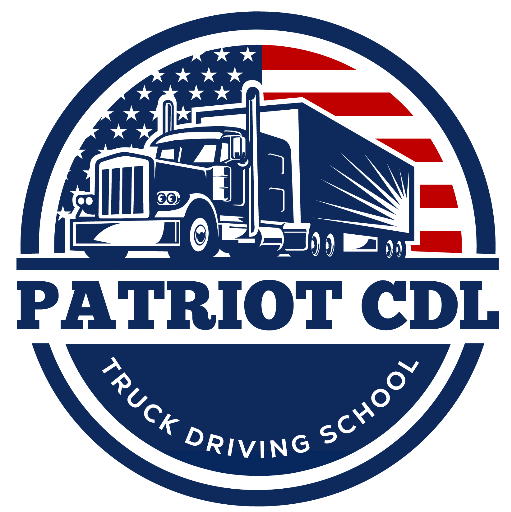So, you're thinking about a career on the open road. It's a fantastic goal, but before you can even think about climbing into the cab of a big rig, there are a few fundamental boxes you have to check. Getting your Commercial Driver's License (CDL) Class A isn't just about passing a test; it's about meeting a strict set of federal and state standards designed to keep everyone safe.
Think of this first phase as building the foundation for your entire trucking career. Getting the details right now—from age to paperwork—prevents major headaches down the road and sets you up for a smooth start.
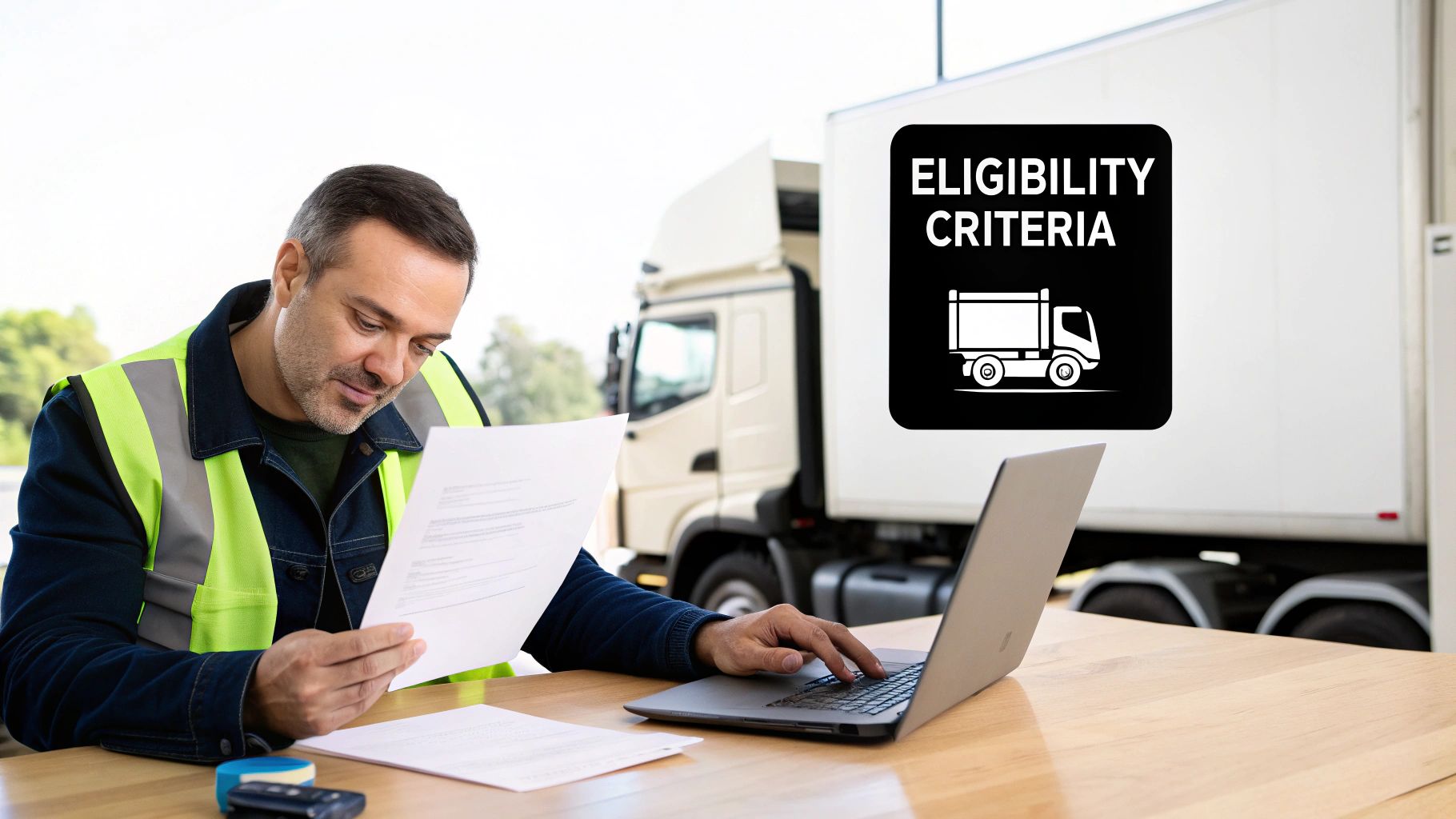
The CDL Class A is the top-tier license for a professional driver. It gives you the authority to operate combination vehicles with a Gross Combination Weight Rating (GCWR) of 26,001 pounds or more, provided the trailer you're hauling weighs over 10,000 pounds. We're talking about the tractor-trailers you see on the highway every day. To ensure a consistent standard of safety and skill across the country, these core requirements are set at the federal level.
First Things First: The Federal Baseline
Before your state's DMV even enters the picture, you have to meet the baseline standards laid out by the Federal Motor Carrier Safety Administration (FMCSA). These are the non-negotiables for every single aspiring trucker in the U.S.
The most important one right out of the gate is your age. It directly determines the kind of driving you'll be legally allowed to do.
- Intrastate Driving: At 18 years old, you can get a CDL and operate a commercial vehicle within your home state's borders.
- Interstate Driving: If you want to cross state lines—which is what most long-haul trucking jobs require—you absolutely must be 21 years old.
This age distinction is a big deal. Many of the highest-paying, long-haul jobs are only available to drivers who are 21 or older, so it's a critical factor in planning your career path.
Getting Your Paperwork in Order
Once you've confirmed you meet the age requirement, it's time to gather your documents. This is a simple but crucial step. Showing up to the DMV unprepared is one of the most common rookie mistakes, and it can stop your application in its tracks.
Don't let a missing piece of paper be the reason you get turned away. Get everything organized in a folder ahead of time. It shows you're serious and makes the whole process go faster.
Typically, you'll need to bring the following with you to apply for your commercial learner's permit:
- Your current, valid driver's license.
- Proof of U.S. citizenship or lawful permanent residency. This could be a U.S. passport, birth certificate, or Green Card.
- Your Social Security card to verify your SSN.
- Two documents proving you live in the state, like recent utility bills or a bank statement.
These documents confirm your identity and legal right to work in the United States. It might seem like just a bureaucratic step, but it's as essential as knowing how to do a proper vehicle inspection. Speaking of which, it's never too early to start learning the ropes of a thorough pre-trip inspection.
To make it even clearer, here's a quick look at the federal rules of entry.
Federal Baseline Requirements at a Glance
This table breaks down the absolute minimums set by the federal government. Every applicant must meet these standards before moving on to state-specific requirements and testing.
| Requirement | Federal Standard | Key Details |
|---|---|---|
| Minimum Age | 18+ for intrastate, 21+ for interstate | Your age determines whether you can drive locally or across state lines. |
| Citizenship/Residency | U.S. Citizen or Lawful Permanent Resident | You must provide official proof, like a passport, birth certificate, or Green Card. |
| Valid Driver's License | Must hold a valid, non-commercial license | You can't get a CDL without first having a standard driver's license. |
| Social Security Number | Required for identification and background checks | Your Social Security card is the primary proof needed. |
Meeting these initial requirements is your green light to start the official CDL training and application process. Once this foundation is set, you can move on to the next steps, like the medical exam and knowledge tests.
Passing the Mandatory Medical and Physical Exams
Let's be blunt: handling a vehicle that can weigh up to 80,000 pounds is a massive responsibility. It's about more than just your skill behind the wheel—your physical and mental fitness are absolutely critical. Think of the DOT physical exam as the pre-flight check for you, the driver. It’s there to make sure you're up to the task of safely managing a rig day in and day out.
This exam isn't just a suggestion; it's a federal requirement set by the Federal Motor Carrier Safety Administration (FMCSA) to create a consistent health standard for all commercial drivers. The goal isn't to find perfect athletes. It's simply to confirm that you don’t have any medical issues that could get in the way of operating a large truck safely over long hauls.
What to Expect During Your DOT Physical
Your first move is to find a certified pro. The FMCSA keeps a National Registry of Certified Medical Examiners, and you have to go to someone on that list. They’re the only ones authorized to conduct the exam and sign off on your medical certificate.
During the appointment, the examiner will give you a thorough once-over, focusing on several key areas:
- Vision and Hearing: Can you see the road signs and hear that car in your blind spot? You’ll need at least 20/40 vision in each eye (glasses or contacts are fine) and good enough hearing to perceive a "forced whisper" from a set distance.
- Blood Pressure and Pulse: High blood pressure can be a serious risk on the road, so your numbers need to be in a safe range. The examiner will check this to make sure you're not at risk for hypertension-related problems.
- Urinalysis: This is a quick and simple screen for underlying issues like diabetes. The test looks for things like sugar, protein, or blood in the urine, which can be early indicators of a health problem.
- Overall Physical Health: The examiner will go over your medical history and perform a basic physical check of your heart, lungs, and general physical ability.
Once you pass, you’ll get your Medical Examiner's Certificate (MEC). This little piece of paper is a huge part of your CDL application and is usually valid for up to 24 months. It’s the official proof that you meet the national health and fitness standards for a professional driver.
Navigating Common Health Conditions
Some health issues can be a roadblock if they aren't properly managed. Uncontrolled diabetes, high blood pressure, epilepsy, or certain heart conditions are taken very seriously because of the potential risk they pose. But having a medical condition doesn't automatically mean your trucking career is over before it starts.
A medical condition is not an automatic disqualification. The key is demonstrating that your condition is well-managed and won't interfere with your ability to drive safely.
In many situations, you can apply for special exemptions or waivers from the FMCSA. This usually involves getting extra paperwork from your own doctors to prove your condition is stable and won't endanger you or anyone else on the road. For a deeper dive into these specifics, you can check out more detailed CDL requirements to see how different health scenarios are handled. Your best bet is always to be proactive and completely honest with the medical examiner—it makes the whole process go a lot smoother.
Earning Your Commercial Learner's Permit
Your path to a Class A CDL doesn’t start on the highway; it starts in a classroom. The very first milestone on this journey is getting your Commercial Learner's Permit (CLP). The best way to think of a CLP is like a student driver’s license, but for a big rig. It's the official document that says you can start practicing behind the wheel, as long as you have a licensed pro with you.
But before you can even think about getting in the driver's seat, you have to prove you know your stuff by passing a few written tests. These aren't your average pop quizzes. They're designed to make sure you have a solid grasp of what it takes to operate a massive, powerful vehicle safely.
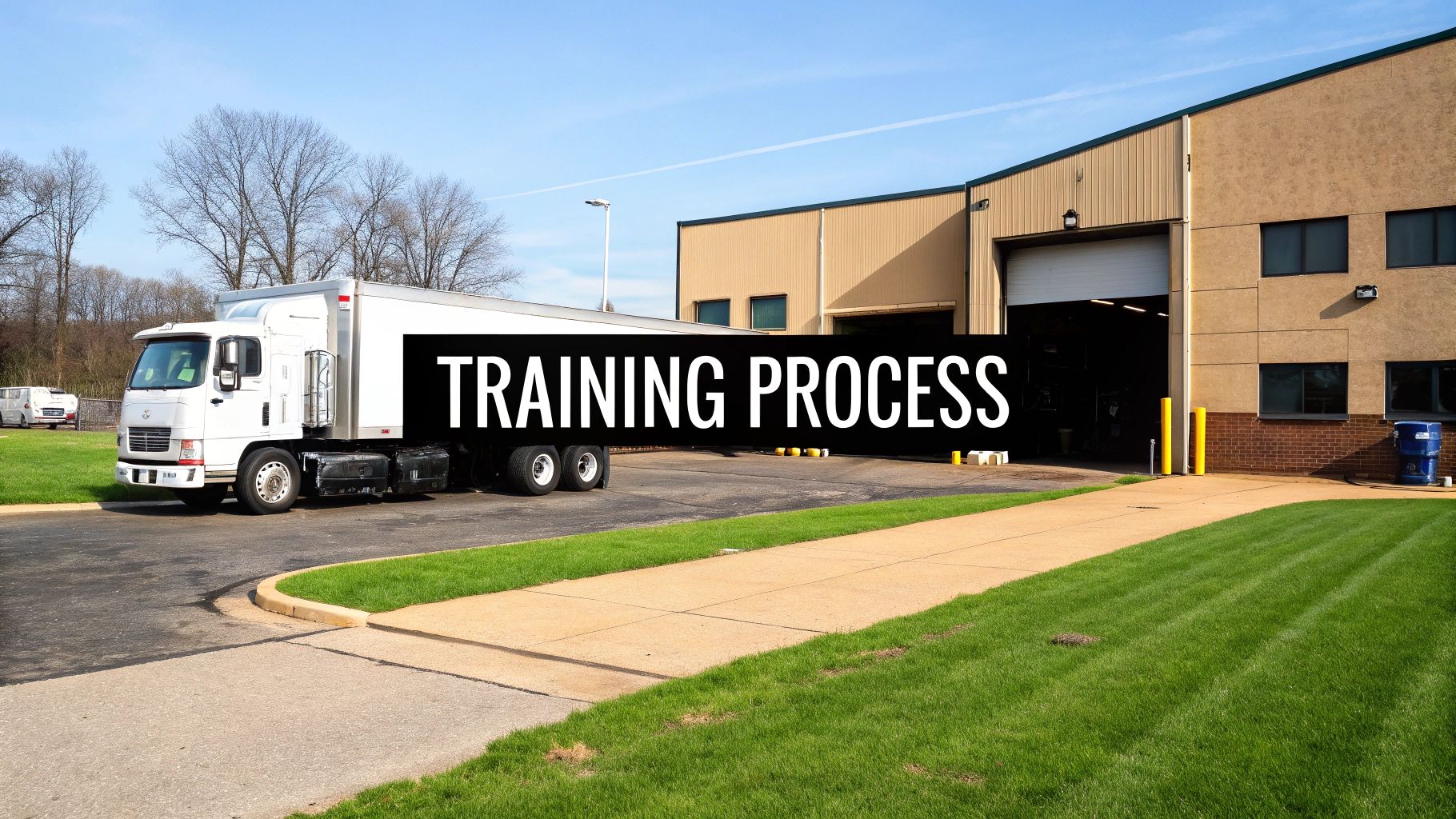
Conquering the Written Knowledge Tests
To get your CLP, you’ll need to pass three key written exams. Most states require you to score at least an 80% on each one, so you'll want to hit the books. These tests are the foundation of your entire trucking career.
- General Knowledge: This is the big one. It covers a huge range of topics, from basic vehicle control and seeing hazards on the road to handling emergencies and knowing the federal rules of the road.
- Combination Vehicles: Since you're going for a Class A, this test is all about the unique physics of driving a tractor-trailer. It dives into coupling and uncoupling, making wide turns without taking out a street sign, and how to keep the trailer from rolling over.
- Air Brakes: Nearly every Class A rig uses air brakes, making this test a must-pass. You'll need to know exactly how these systems work, how to properly inspect them before a trip, and how to use them effectively.
Passing these three exams shows the DMV you have the book smarts needed for a Class A license. The single best resource you have is your state's official CDL manual—it has everything you’ll be tested on. You can learn more about getting your permit and see what these first hurdles really look like.
The Rules of the Road with a CLP
Getting your CLP doesn't mean you're suddenly free to hit the road alone. Far from it. There are strict rules you have to follow while you're in the training phase.
A CLP is your license to learn, not a license to drive solo. It’s a period of supervised practice designed to build your skills safely before you take the final road test.
Thanks to the Commercial Motor Vehicle Safety Act, which went into effect way back on April 1, 1992, these rules are pretty standard across the country. One of the most important ones is that you have to hold your CLP for a minimum of 14 days before you can even attempt the final CDL skills test. Also, keep in mind that a CLP is usually only good for one year and you can't renew it.
This mandatory waiting period is there for a reason—it gives you time to get comfortable behind the wheel. And anytime you are driving, you must have a licensed CDL holder sitting right next to you in the passenger seat. This on-the-road training is where the rubber really meets the road, allowing you to turn classroom theory into real-world skill with an expert guiding you.
Mastering the Three-Part CDL Skills Test
You've passed your written exams and logged your training hours. Now for the final hurdle: the hands-on skills test. This is where the rubber literally meets the road, and you prove to the state examiner that you can handle a commercial vehicle safely and confidently. It’s no walk in the park; the test is a rigorous, three-part evaluation that covers everything from pre-trip checks to real-world driving.
Think of it as the ultimate final exam for a professional driver. It's designed to see if you have the precision, control, and deep-seated commitment to safety needed to operate a tractor-trailer. Let's break down what you’ll face.
The Vehicle Inspection Test
The very first part of your skills test happens before you even start the engine. You’ll perform a full pre-trip vehicle inspection, but with a twist—you have to narrate the entire process for the examiner. This isn't just about kicking the tires; it's a verbal test of your mechanical knowledge.
You'll need to walk the examiner around the truck and trailer, pointing to specific components and explaining what you’re looking for. You’ll be expected to identify and check key systems like:
- Engine Compartment: You'll point out belts and hoses, check fluid levels, and explain how you'd spot potential leaks.
- Braking System: Get ready to talk about air lines, brake chambers, slack adjustors, and drums, showing you know what a safe system looks like.
- Coupling System: This involves checking the fifth wheel, ensuring the locking jaws are secure around the kingpin, and verifying a solid connection.
- Tires and Wheels: You'll discuss proper tread depth, demonstrate how you'd check air pressure, and explain why tight lug nuts are critical.
This part proves you know your vehicle inside and out and can spot a safety hazard before it ever becomes a problem on the highway.
The Basic Control Skills Test
Once the examiner is satisfied the rig is safe, it’s time to show off your maneuvering skills. You’ll head to a closed course, away from traffic, to perform a series of specific backing and parking exercises. This is all about low-speed precision and demonstrating your command of the vehicle in tight spots.
Most states test a few core maneuvers, which often include:
- Straight-Line Backing: Sounds simple, but keeping an 80-foot rig perfectly straight while reversing takes practice and a feel for the trailer.
- Offset Backing: You'll have to back the truck into a lane that’s one lane over, either to your right or left.
- Alley Dock or Parallel Parking: This is the one that trips up most new drivers. You’ll need to put the trailer into a space simulating a loading dock or a parallel parking spot, often with very little room for error.
The examiner is watching to see if you can complete these without hitting cones, crossing boundary lines, or making excessive pull-ups. Brushing up on the vehicle dynamics you learned for the general knowledge test can be a huge help here, as it reinforces why the truck and trailer behave the way they do.
The entire CDL Class A process is a step-by-step journey, from getting your paperwork in order to acing this final road test.
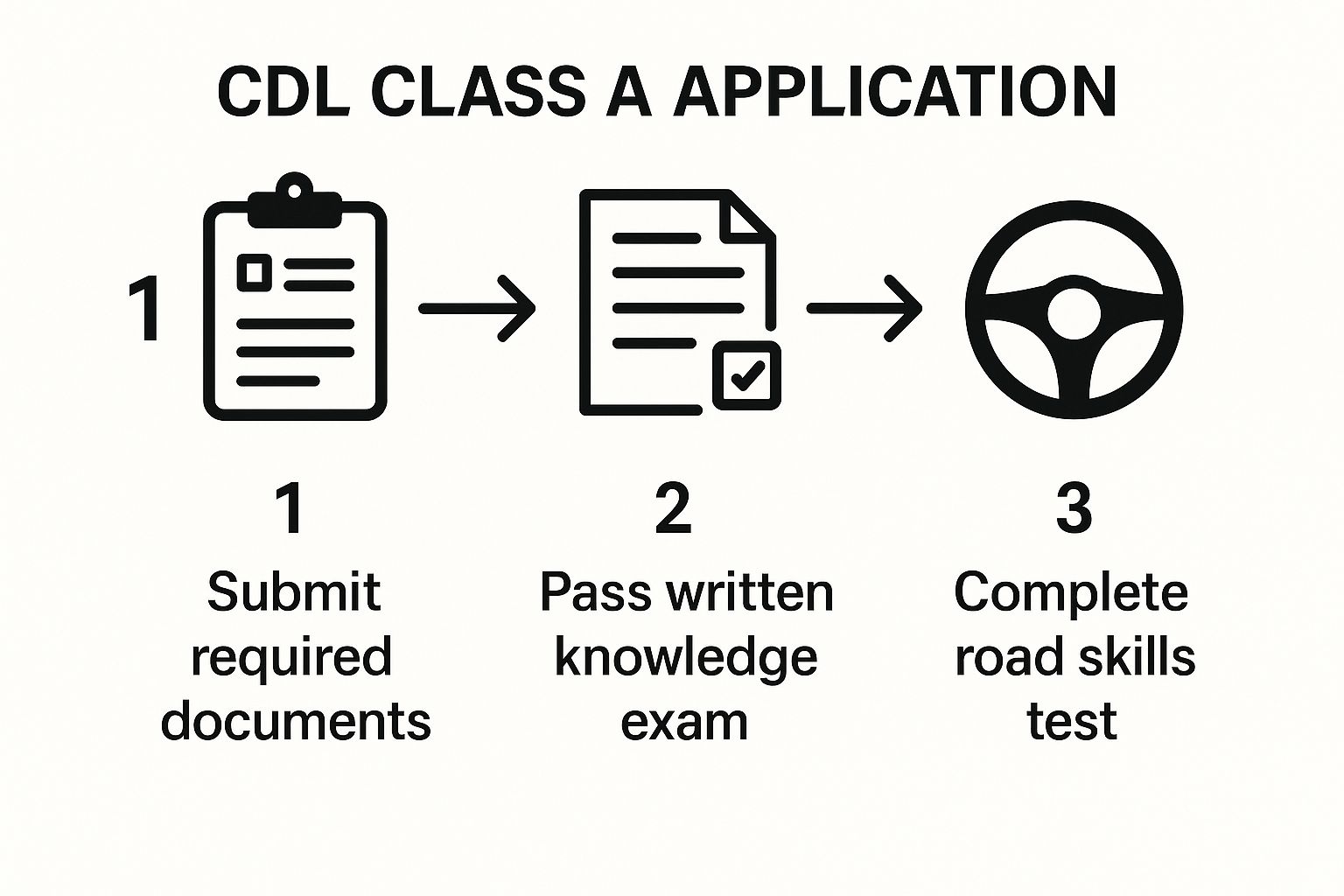
As you can see, each piece—documentation, knowledge exams, and the skills test—builds on the last, bringing you closer to earning that license.
The On-Road Driving Test
Finally, the moment of truth. You’ll take the truck out on public roads with the examiner right there in the passenger seat, evaluating your every move. This is your chance to show you can operate safely and professionally in the real world, surrounded by traffic.
The on-road test isn't about being fast or flashy. It's about being smooth, safe, and predictable. The examiner wants to see a defensive driver who follows the rules of the road to the letter.
During the drive, you’ll be tested on your ability to handle intersections, execute proper turns (without climbing curbs!), change lanes smoothly, and merge onto highways. The examiner will be watching your mirror checks, your signaling, how well you manage your speed, and whether you maintain a safe following distance. Pass this, and you’ve officially proven you have what it takes to join the ranks of America's professional drivers.
More Than Just a License: Why Endorsements Matter
Getting your CDL Class A is a huge accomplishment—it's your ticket into the world of professional driving. But if you want to access the best routes and the highest-paying jobs, you’ll need to add endorsements.
Think of your basic CDL as a high school diploma. It gets you in the door. Endorsements are like a specialized trade certification or a college degree—they prove you’ve got the advanced skills to handle more complex, valuable, or potentially hazardous cargo. For each one, you'll need to pass an additional written knowledge test, and some have extra hoops to jump through.
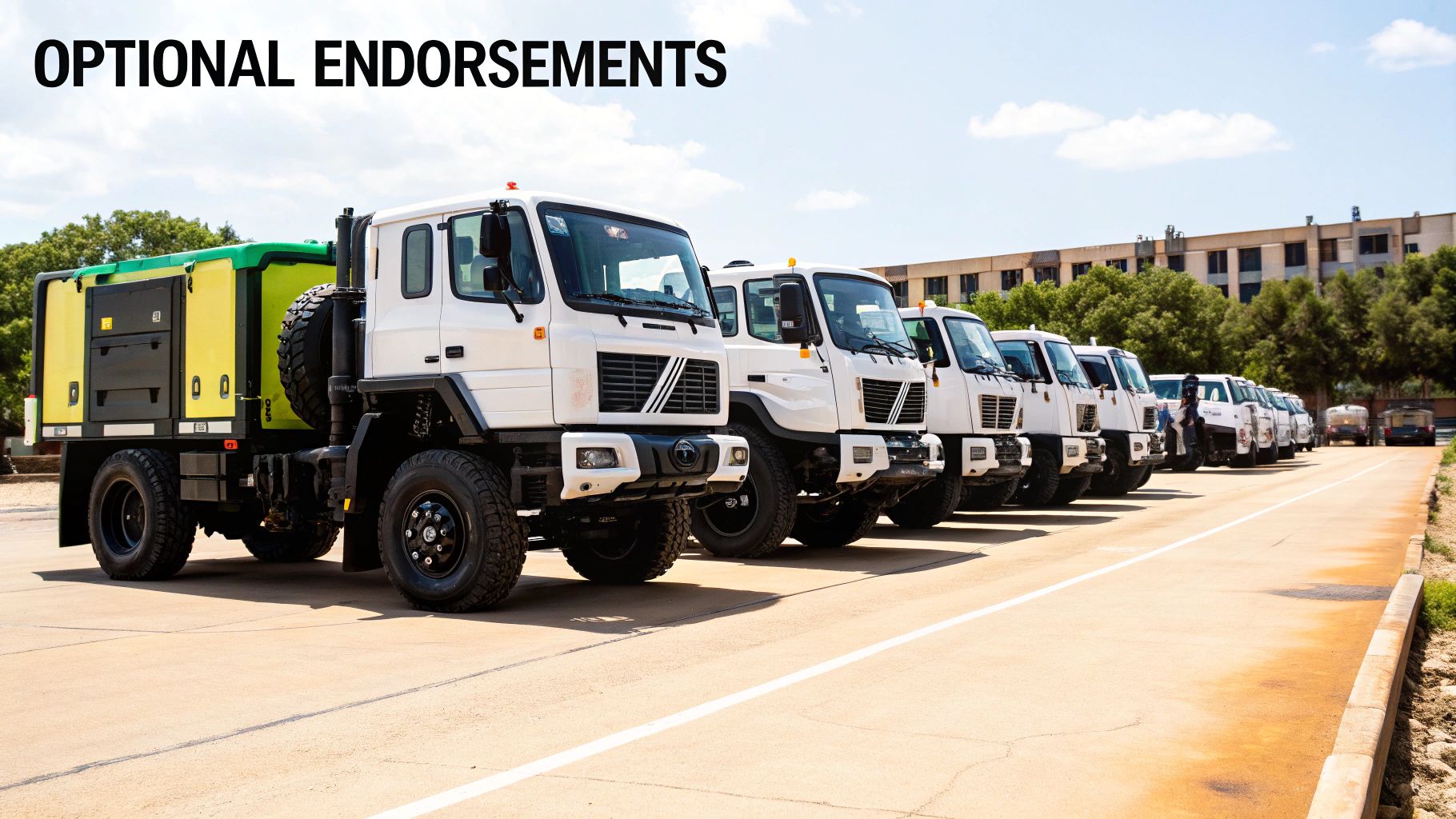
The Most Valuable CDL Endorsements
While there are several endorsements you can get, a few really stand out for opening up your career options. Let's break down the big ones that trucking companies are always looking for.
- (T) Double/Triple Trailers: This one gives you the green light to pull two or three trailers at once. The written test focuses on the unique challenges that come with handling such long, heavy, and often tricky combinations. It’s a different ballgame.
- (N) Tank Vehicle: If you want to haul liquids or gases, you need the N endorsement. The test covers critical safety knowledge, like dealing with a high center of gravity and the "slosh" effect of moving liquid, which can seriously impact how your truck handles on the road.
- (H) Hazardous Materials (Hazmat): This is where the big money often is. The H endorsement allows you to transport everything from fuel and industrial chemicals to other regulated materials. As you'd expect, the process to get this one is much more involved.
- (X) Combination Tank/Hazmat: Many drivers go for this combo endorsement. It merges the N and H, letting you haul hazardous materials in a tank truck—think fuel tankers. To get the X, you have to pass both the Tanker and Hazmat knowledge tests.
Getting endorsements is about more than just passing a test; it’s an investment in your career. A driver with Hazmat and Tanker endorsements is often more valuable to a company than a driver without them, leading to better routes and higher pay.
Diving Deeper: The Hazmat Endorsement
The H endorsement is in a league of its own because of the extra security screening. Since you'll be responsible for materials that could be dangerous if they fall into the wrong hands, you have to pass a federal security threat assessment.
This whole process is handled by the Transportation Security Administration (TSA). You’ll fill out a detailed application, provide your fingerprints, and undergo a comprehensive background check. The TSA is looking to make sure that people with certain criminal convictions can't get access to these sensitive loads.
This is a critical part of the cdl class a requirements for any aspiring Hazmat driver. My advice? Start this process early. The background check isn't instant and can take several weeks to clear, so you don't want it holding you up.
Common CDL Class A Endorsements and Their Requirements
Endorsements directly translate into more diverse and often more lucrative driving opportunities. Here’s a quick comparison of the most popular options and what it takes to add them to your license.
| Endorsement Code | What It Allows | Required Test(s) | Additional Requirements |
|---|---|---|---|
| T | Driving with double or triple trailers. | Written Knowledge Test | — |
| N | Hauling liquids or gases in a tank vehicle. | Written Knowledge Test | — |
| H | Transporting hazardous materials. | Written Knowledge Test | TSA Security Threat Assessment (background check). |
| X | Hauling hazardous materials in a tank vehicle. | Written Tanker Test & Written Hazmat Test | TSA Security Threat Assessment (background check). |
As you can see, a little extra study time and some paperwork can dramatically increase your value as a driver and put you on the fast track to a more rewarding career.
Understanding the Trucking Industry You Are Joining
Getting your CDL Class A is the first step, but it’s just as important to know what you’re getting into. Think of it this way: you wouldn't just learn the rules of a game; you'd want to understand the players, the field, and the culture surrounding it.
The trucking industry is more than a job—it's a lifestyle and the lifeblood of the American economy. Knowing what to expect on and off the road will set you up for success far better than just knowing how to pass the test.
A Look at the Modern Driver
When you get behind the wheel, you'll be joining a massive community of professionals. There are roughly 1.2 million CDL Class A drivers on the road in the United States, so you're in good company.
The current workforce is experienced, with the average driver's age hovering around 48 years. It's also a field dominated by men, as women currently make up just under 7% of all drivers. This isn't just a statistic; it points to a huge opportunity for new and diverse talent to build a solid career.
High turnover is a well-known reality in trucking, sometimes hitting 95% for certain types of long-haul jobs. While that sounds intense, it creates constant demand for qualified, committed drivers.
This driver churn means that if you've got the skills and the right attitude, job security is practically a given. The key is to find a good company that genuinely invests in its people. Understanding this dynamic from day one will help you navigate your career and find a role where you can truly thrive.
Your Top Questions About CDL Class A Requirements Answered
When you're first looking into getting a Class A license, a million questions probably pop into your head. It's totally normal. Let's tackle some of the most common ones I hear from aspiring drivers to clear things up and help you map out your next steps.
How Long Does It Take to Get a CDL?
This is the big one, right? Realistically, you can expect most full-time CDL training programs to take anywhere from three to eight weeks.
Of course, this isn't set in stone. If you go with a part-time program to fit around your current job, it’ll naturally take a bit longer. Other things can affect your timeline too, like how backed up your state's DMV is for permit processing or how far out they're scheduling road tests.
Will a Criminal Record Disqualify Me?
A criminal record doesn't automatically mean you can't get a CDL. It really depends on the nature of the offense. While many past mistakes won't stop you, some serious felonies will—especially those involving a commercial vehicle or that pose a risk to transportation safety.
Be aware that certain endorsements have much stricter rules. If you're going for a Hazmat endorsement, for example, the TSA will run a deep-dive background check and has a specific list of crimes that will disqualify you.
A quick but important note on age: The difference between intrastate and interstate driving all comes down to state lines. An 18-year-old can get a CDL to drive a big rig anywhere within their home state (intrastate). But to haul freight across the country, you need to be at least 21 (interstate).
What Is the Total Cost for a CDL?
Getting your CDL is an investment in your future, and that investment typically falls somewhere between $3,000 and $10,000.
The bulk of that cost is your truck driving school tuition, which pays for all your classroom learning and, most importantly, your time behind the wheel. On top of that, you’ll have smaller fees for things like your permit application, the various written tests, your final skills exam, and the DOT medical card.
Also, keep potential license restrictions in mind. If you take your road test in a truck with an automatic transmission, your license will have a restriction that prevents you from driving a manual. If you want the freedom to drive any rig, our guide on the E restriction removal course walks you through how to get that limitation lifted.
Ready to stop wondering and start driving? At Patriot CDL, we offer fast-paced, hands-on training designed to get you licensed and on the road to a new career. https://patriotcdl.com
